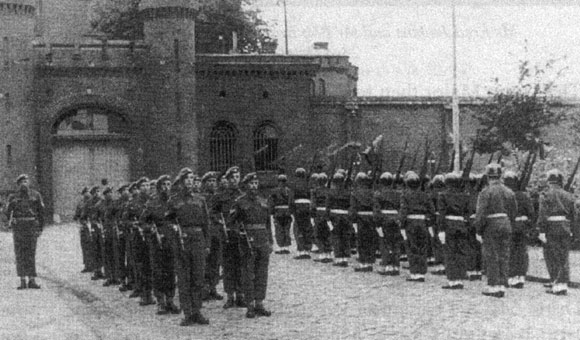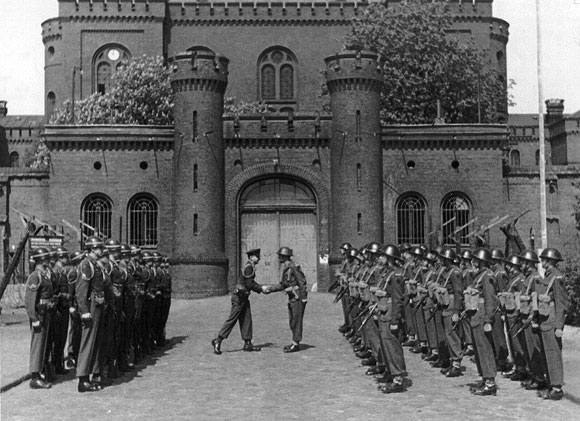The Berlin Airlift
John Roll in Berlin
I flew into blockaded Berlin aboard a Dakota aircraft, from Dortmund, after spending a few weeks in hospital in Iserlohn rejoining the battalion who were then quartered in the Olympic Stadium.
Life in Berlin between June '48 and May '49 was hard work for the rifle company's as the Regiment had to supply 100 men daily for guard duties throughout the city, not counting a company for Spandau Prison. Most were for 24 hour periods. some high profile, such as the GOC's Residence, the Control Commission HQ, Gatow Air Field and Spandau. Some others were an RAOC Depot, Food and Coal stores not forgetting a ward in BMH, these came up every other day. After a while life became very tedious indeed, however, some amusing incidents occurred. The Germans had constructed a Flak Tower in the Tiergarten as part of the defence of the city, and now it was to be demolished, The Royal Engineers spent weeks drilling holes round the base. then packing them with explosives. The great day dawned, the civilian population turned out to watch. Bang went the detonation, a cloud of black smoke, when it cleared there was the Tower which had only just slipped sideways, with loud cheers and jeers ringing in our ears, we made a hasty retreat. On the GOC residence, the guards wore slippers to cut down the noise on the gravel (Sir Brian slept soundly!)

C Company Queen's, Dismounting Guard at Spandau Prison, 1st June 1949. Sgt Joe Norman Guard Commander,
Cpl Keith Yonwin and Cpl Les Jessup
The Control Commission Headquarters was the worst one of all. In the hall, there on the wall was a great big clock. This monstrosity jumped every minute with a big clank. Not so bad during the day, but at night it was murder. Every time a minute went by, your eyes automatically went to it, for two hours, the longest hours I have ever spent. Spandau Prison, now here was a high profile guard. This was taken over by C Company on the First of May 1949 from the Americans (if my mind serves me correct) there were seven posts.
No 1, inside the main doors, the rest at intervals on the walls. These consisted of a wooden hut approx. 3ft x 3ft, the sides halfway up then glass to the roof, this was built on a platform about 8 ft square. The sentry was not allowed inside only to phone the guard room, on the hour and clock in by ticker tape, on the half. The sides to the platform, were mounted with two Bren's and two searchlights, your personal weapon a Sten, to reach it was by an iron rung ladder, this lowered by the man being relieved then pulled up on the change over. There was one addition to the seven sentries, an escort for any visitors the prisoners may have, staying with them till they departed.
Inside the main gates, on the right, lay the guards rest room, opposite the guard room next to this the four allied officers quarters. The rest of the company not on duty lived just outside the walls. During that month, the Blockade was lifted. We were relieved by the French on the 1st June.

C Company Queen's at Spandau Prison.
When rested from Guard Duties, training exercises were the order of the day, river crossings on the Havel, house and building clearing, this taking place in the old Luffwaffe Barracks at Gatow, also schemes in the Grunwald. Our food was not inspiring, Pom with everything, this being a powdered substitute for potato, the cooks speciality, cheese and Pom pie and I'm sure the cheese was powdered as well, it was horrible. We were always hungry, the NAAFI and Toc H made a fortune out of us.
Xmas 1948, the Battalion gave a party for some German children. Each man gave up his weeks chocolate ration, this was broken up, so they had to eat it then, not for the parents to barter with. At the end of the party they sang to us, that old carol, Holy Night. Today when I hear it sung in German, a picture of those children comes to me. Survival was the main thing to these kids. They would dig a trench across the earth track, leading up to the coal depot, so open lorries loaded with loose coal, bump down it, a few lumps would fall off, then a big scramble to grab it and run.
I said at the start, the duties were heavy in the Rifle Coy's, it must also have been for the rest of the Regiment. In C Coy we had some of the best NCO's in the Battalion. CSM Vail, Sgt's Joe Norman, Frank Dowland, Cpl's Keith Yonwin and Les Jessup. They were greatly respected.
In November 1949, our tour of duty in Berlin came to a close and we moved by road to Aldershot Barracks, Iserlohn, here I left the Battalion in the early 50's.
Looking back to those days how quickly I grew up. I am proud to have served in The Queen's Royal Regiment.
John Roll
Related
